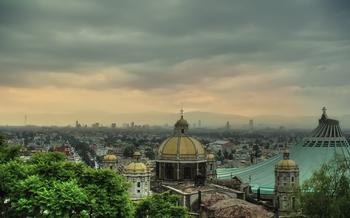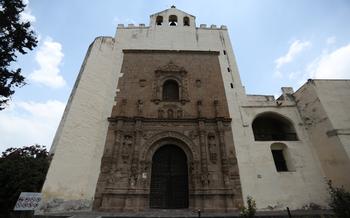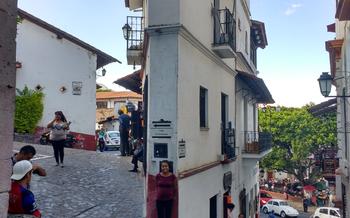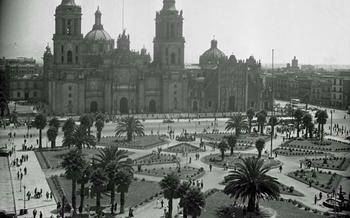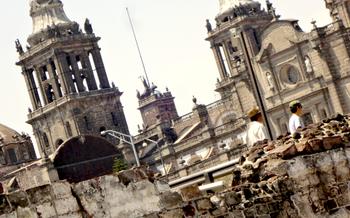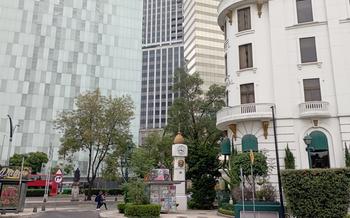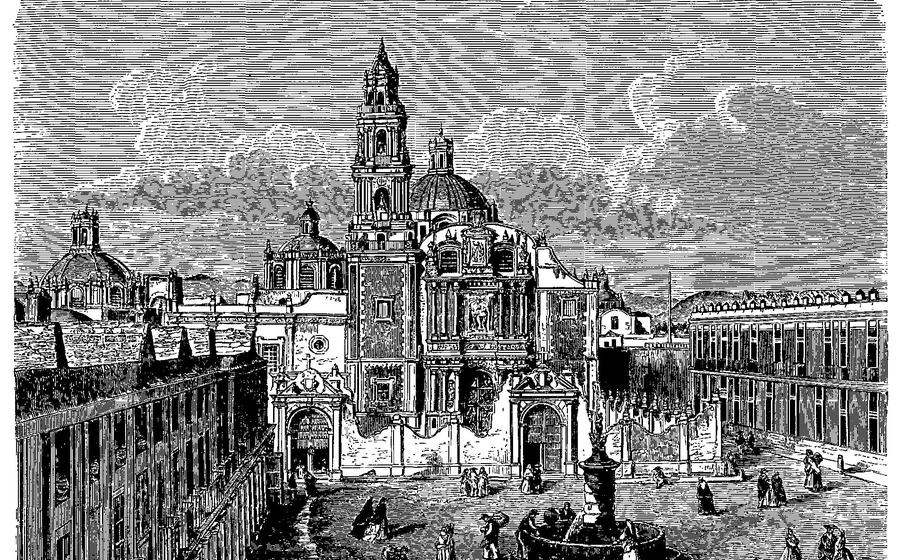
Plaza de Santo Domingo
- Historical Significance:
- Santo Domingo Church
- Cafe de Tacuba: A Culinary Legacy in the Heart of Mexico City
- Museo de la Memoria y la Tolerancia: A Journey of Understanding
- Casa de la Primera Imprenta en América
- Templo de Nuestra Señora del Pilar y Santiago
- Templo de la Profesa
- Museo del Estanquillo: A Quirky Celebration of Mexican Popular Culture
- Plaza de la Solidaridad: A Place of Protest and Political Expression
- Hostal de Santo Domingo: A Haven for Budget Travelers and Backpackers
- Nightlife in Plaza de Santo Domingo
- Street Art and Murals
- Insider Tip:
Historical Significance:
The Plaza de Santo Domingo stands as a testament to Mexico City's rich history and cultural heritage. Its roots trace back to the 16th century when it served as a bustling marketplace for merchants, exchanging goods and ideas from across the region. The plaza's significance grew under the patronage of the Dominican Order, who established the Templo de Santo Domingo, a magnificent church that became a spiritual and intellectual hub for the city's elite. Over the centuries, the plaza has witnessed countless events and gatherings, from religious processions to political rallies, leaving an indelible mark on Mexico's history. Its buildings and monuments whisper tales of a bygone era, where the clash of cultures and the struggle for power shaped the destiny of a nation.
Santo Domingo Church
The architectural grandeur of the Santo Domingo Church is a testament to the fusion of Baroque and Gothic styles. Its facade, adorned with intricate carvings and sculptures, invites visitors to step inside and explore the marvels that await. The interior, equally captivating, showcases a symphony of gold leaf, intricate altarpieces, and awe-inspiring paintings. Each element blends harmoniously, creating a sacred space that exudes both opulence and serenity.
The church holds a significant place in Mexico's history, having witnessed numerous pivotal events and graced by notable figures. It served as the headquarters of the Dominican Order, playing a crucial role in the evangelization of Mexico. Over the centuries, the church has welcomed countless pilgrims, offering solace, guidance, and spiritual renewal.
Among the notable features of the Santo Domingo Church is the Capilla del Rosario, a smaller chapel located within the main structure. Dedicated to the Virgin of the Rosary, this chapel is adorned with exquisite murals depicting scenes from the life of the Virgin Mary. The intricate details and vibrant colors of these murals are a testament to the artistic mastery of the colonial period.
Visiting the Santo Domingo Church is an immersive experience that transports visitors back in time. The fusion of architectural styles, the sacred ambiance, and the rich history combine to create a profound and memorable encounter. Whether seeking spiritual enlightenment or simply appreciating architectural beauty, the Santo Domingo Church is a must-visit destination for anyone exploring the heart of Mexico City.
Cafe de Tacuba: A Culinary Legacy in the Heart of Mexico City
In the bustling heart of Mexico City, nestled within the historic Plaza de Santo Domingo, lies a culinary gem that has stood the test of time: Cafe de Tacuba. Established in 1912, this iconic restaurant has earned a reputation as one of the oldest and most beloved dining destinations in the city, attracting locals and visitors alike with its traditional Mexican cuisine and rich historical charm.
Step through the doors of Cafe de Tacuba and be transported to a bygone era, where intricate tilework, colorful murals, and vintage decor create a vibrant and inviting ambiance. The air is filled with the tantalizing aromas of mole poblano, a signature dish that has become synonymous with the restaurant's culinary prowess.
The menu at Cafe de Tacuba is a testament to the diversity and richness of Mexican gastronomy. From classic dishes like enchiladas and tacos to regional specialties such as pozole and tlalpeno soup, there is something to satisfy every palate. The restaurant takes pride in using fresh, local ingredients, ensuring that each dish is a celebration of Mexican flavors and traditions.
Among the must-try dishes at Cafe de Tacuba is the legendary mole poblano, a complex and flavorful sauce made with over 20 different ingredients, including chocolate, chili peppers, and spices. The result is a rich, smoky, and slightly sweet sauce that perfectly complements the tender chicken or pork it is served with.
Another highlight of the menu is the churros, a traditional Spanish dessert that has become a beloved treat in Mexico. These crispy, golden-brown pastries are served hot and dusted with cinnamon sugar, making them the perfect accompaniment to a cup of rich Mexican coffee or hot chocolate.
With its historical significance, delicious cuisine, and charming ambiance, Cafe de Tacuba is a must-visit for anyone seeking an authentic taste of Mexico City's culinary heritage. Whether you're a foodie, a history buff, or simply looking for a memorable dining experience, this iconic restaurant will leave you with lasting impressions.
Museo de la Memoria y la Tolerancia: A Journey of Understanding
Nestled in the heart of Plaza de Santo Domingo, the Museo de la Memoria y la Tolerancia stands as a testament to the importance of tolerance and understanding in a world often marred by discrimination and injustice. This thought-provoking museum invites visitors to embark on a journey through interactive exhibits and displays that explore the themes of human rights, discrimination, and social justice.
Through powerful personal stories and testimonies, the museum sheds light on the struggles and triumphs of individuals and communities who have faced persecution and prejudice. Visitors are encouraged to reflect on their own biases and prejudices as they navigate through the museum's immersive and educational exhibits.
The museum also highlights the history of social movements and human rights struggles in Mexico, showcasing the tireless efforts of activists and advocates who have fought for equality and justice. By presenting these stories in a compelling and interactive manner, the Museo de la Memoria y la Tolerancia aims to promote empathy, understanding, and a commitment to creating a more inclusive and tolerant society.
For visitors interested in gaining a deeper understanding of Mexico's rich history of social movements and human rights struggles, this museum is a must-visit. Its powerful exhibits and interactive displays offer a unique and emotionally impactful experience that will challenge perspectives and inspire visitors to become advocates for tolerance and understanding.
Casa de la Primera Imprenta en América
The Casa de la Primera Imprenta en América is a museum dedicated to the history of printing in the Americas. It is located in the Plaza de Santo Domingo, in the historic center of Mexico City, and is housed in a building that was once the home of the first printing press in the Americas.
The museum was founded in 1940 and contains a collection of antique printing equipment and replicas of early printed books. Visitors can learn about the history of printing and its impact on the development of Mexico and the Americas. The museum also hosts temporary exhibitions and workshops on printing and bookbinding.
One of the highlights of the museum is the replica of the first printing press that was brought to Mexico by Juan Pablos in 153This press was used to print the first book in the Americas, the "Doctrina Breve," which was a religious text written in Nahuatl, the language of the Aztecs.
The Casa de la Primera Imprenta en América is a valuable resource for anyone interested in the history of printing and its impact on the development of Mexico and the Americas. It is a must-see for visitors to the Plaza de Santo Domingo and for anyone interested in Mexican history and culture.
Templo de Nuestra Señora del Pilar y Santiago
The Templo de Nuestra Señora del Pilar y Santiago stands as a testament to the fusion of architectural styles and religious devotion in the Plaza de Santo Domingo. Its Baroque-style facade, adorned with intricate carvings and sculptures, invites visitors to step into a realm of artistic grandeur. The interior is equally impressive, boasting elaborate altarpieces and paintings that depict biblical scenes and the life of the Virgin of Guadalupe. Pilgrims from across Mexico flock to this sacred site, seeking solace and spiritual guidance. During religious festivals and celebrations, the church transforms into a vibrant hub of devotion, where the faithful gather to honor the Virgin and celebrate her miraculous interventions. For a truly immersive cultural experience, time your visit to coincide with one of these special events and witness the fervent devotion of the Mexican people.
Templo de la Profesa
Templo de la Profesa holds a prominent position in the Plaza de Santo Domingo, captivating visitors with its grandiose Churrigueresque-style facade. Its intricate carvings and gilded ornaments create a dazzling display that reflects the artistry and opulence of the era.
Step inside to discover an equally impressive interior adorned with gold leaf, intricate carvings, and stunning paintings. The main altar, a masterpiece of Baroque art, is a testament to the skill and devotion of the Jesuit craftsmen who created it.
Founded by the Jesuit Order in the 17th century, Templo de la Profesa played a pivotal role in the religious and cultural landscape of colonial Mexico. It was here that the Jesuits educated and influenced generations of Mexican thinkers, artists, and leaders, contributing to the intellectual and spiritual development of the nation.
During the Mexican War of Independence, the church served as a meeting place for patriotic conspirators plotting against Spanish rule. Its walls echoed with whispers of rebellion and dreams of freedom, making it a symbol of resistance and the struggle for independence.
Today, Templo de la Profesa remains a significant religious and cultural landmark in Mexico City. Mass and religious services are held regularly, allowing visitors to experience the spiritual atmosphere of this sacred space. For those seeking a deeper connection to Mexican history and architecture, a visit to Templo de la Profesa is an absolute must.
Museo del Estanquillo: A Quirky Celebration of Mexican Popular Culture
Tucked away in a corner of the Plaza de Santo Domingo, the Museo del Estanquillo is a delightful and eccentric museum that celebrates the rich tapestry of Mexican popular culture. Step inside this quirky space, and you'll be transported to a world of colorful traditions, vibrant imagery, and fascinating artifacts.
The museum's collection is a treasure trove of Mexican memorabilia, showcasing everything from vintage toys and advertising posters to historic photographs and movie stills. Each exhibit tells a unique story about Mexican identity, humor, and everyday life.
Explore the interactive displays that allow you to engage with the exhibits in a fun and interactive way. Listen to traditional Mexican music, watch classic Mexican films, or flip through old magazines to get a glimpse into Mexico's past.
The Museo del Estanquillo is a must-visit for anyone interested in understanding the heart and soul of Mexican culture. Its quirky charm and playful exhibits offer a refreshing perspective on Mexico's history and traditions.
Plaza de la Solidaridad: A Place of Protest and Political Expression
In the heart of Mexico City, adjacent to the Plaza de Santo Domingo, lies the Plaza de la Solidaridad, a significant gathering place for political and social protests and demonstrations. This plaza has witnessed numerous historical events and movements that have shaped the course of Mexican history.
The Plaza de la Solidaridad is a testament to Mexico's rich political and social activism, a place where people have come together to express their discontent, demand change, and fight for their rights. From the student protests of 1968 to the more recent demonstrations against corruption and inequality, this plaza has served as a platform for the voices of the people.
Within the plaza, monuments and sculptures stand as reminders of these struggles and the sacrifices made by those who fought for social justice. The Memorial to the 68 Movement, for example, commemorates the student protests of 1968, while the Fuente de la Solidaridad pays tribute to the victims of the 1985 earthquake.
Visiting the Plaza de la Solidaridad during political or cultural events is a unique experience, allowing visitors to witness the vibrant energy and spirit of Mexico City. The plaza transforms into a sea of flags, banners, and passionate speeches, as people from all walks of life come together to demand change and express their solidarity with one another.
Hostal de Santo Domingo: A Haven for Budget Travelers and Backpackers
For budget-conscious travelers, the Hostal de Santo Domingo offers a comfortable and social accommodation option in the heart of the plaza. With a range of dormitory rooms and private rooms available, the hostel caters to solo travelers, couples, and groups alike. The friendly and welcoming atmosphere makes it easy to meet other travelers from around the world and share experiences.
The hostel's amenities include a rooftop terrace, a common area with a TV and games, and a shared kitchen where guests can prepare their own meals. The staff is knowledgeable and helpful, providing recommendations for activities and attractions in the city.
Whether you're looking to save money on accommodation or simply enjoy the social atmosphere of a hostel, the Hostal de Santo Domingo is an excellent choice for travelers visiting Mexico City. Its convenient location, affordable prices, and friendly vibe make it a popular favorite among budget travelers and backpackers.
Nightlife in Plaza de Santo Domingo
As the sun sets, the Plaza de Santo Domingo transforms into a vibrant hub of nightlife activity. The air fills with music, laughter, and the clinking of glasses as locals and tourists alike flock to the plaza's many bars, restaurants, and nightclubs.
La Botica, a popular bar housed in a former pharmacy, is known for its creative cocktails and lively atmosphere. El Imperial, a two-story venue, offers a mix of live music, DJs, and dancing, attracting a diverse crowd of partygoers.
For a more relaxed evening, visitors can head to one of the many restaurants in the plaza, where they can enjoy traditional Mexican cuisine and soak up the lively atmosphere.
Whether you're looking to dance the night away, sip on handcrafted cocktails, or simply people-watch, the Plaza de Santo Domingo has something to offer everyone.
Insider Tip:
For a truly unique nightlife experience, head to the nearby Salon Los Angeles, a legendary dance hall that has been operating since the 1930s. This iconic venue hosts live music performances, dance lessons, and themed nights, offering a glimpse into Mexico City's rich cultural heritage.
Street Art and Murals
As you wander through the Plaza de Santo Domingo and its surrounding streets, you'll be greeted by a vibrant display of street art and murals that adorn the walls and buildings. These artistic creations, crafted by local and international artists, showcase a diverse range of styles and techniques, adding a unique and colorful touch to the historic plaza.
The murals often explore themes of social justice, cultural identity, and environmental issues, providing a glimpse into the thoughts and perspectives of the artists and the community they represent. Take the time to admire the intricate details and powerful messages conveyed through these works of art, which serve as a testament to the vibrant artistic scene in Mexico City.
One particularly striking mural, located on the corner of República de Chile and Belisario Domínguez, depicts a group of women dressed in traditional Mexican attire, their arms raised in defiance against a backdrop of vibrant colors and symbols. This powerful piece, created by the renowned artist Frida Barragán, celebrates the strength and resilience of women in Mexican society.
As you continue your exploration, keep an eye out for hidden gems tucked away in unexpected corners. You might stumble upon a small alleyway adorned with whimsical graffiti or a stunning mural covering the entire facade of a building. These hidden treasures add to the charm and character of the plaza, making it a delightful place to wander and discover new artistic expressions at every turn.
Insider Tip:
Venture beyond the main attractions of the Plaza de Santo Domingo and discover the hidden gem of the Libreria Porrúa. This charming bookstore, located just a few steps from the plaza, is a treasure trove for bookworms and history enthusiasts. Step inside and be transported back in time as you browse through shelves lined with antique books, rare editions, and literary classics. The knowledgeable staff is always happy to assist you in finding that perfect read. Whether you're a passionate reader or simply looking for a unique souvenir, the Libreria Porrúa is a must-visit for anyone exploring the Plaza de Santo Domingo.

